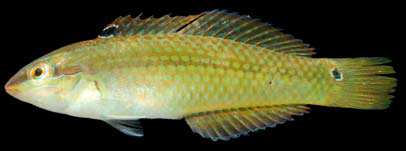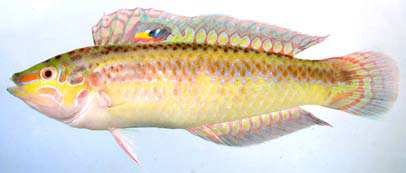| LABRIDAE |

Halichoeres bicolor, 4.9 cm SL
(initial phase; photo by Seishi Kimura)

Halichoeres bicolor, 7.5 cm SL
(terminal phase; photo by Ukkrit Satapoomin)
|
Halichoeres bicolor (Bloch and Schneider, 1801) Brown-striped Wrasse |
|
D IX, 11-12; A III, 12; P1 14-15; LLp 27-28. Body elongate; snout pointed; anterior teeth in upper and lower jaws enlarged to form canines; snout, cheek, opercle, and behind eye naked, scales on nape nearly reaching to a vertical at posterior edge of orbit; lateral line complete; caudal fin rounded. Color: ground color of body pale brown to olive in adults, greenish in small juveniles; two brownish black (in juveniles) or reddish brown (in adults) longitudinal stripes on side of body, the upper along back, the lower at mid-lateral from the edge of opercle to caudal fin base. Head with a reddish brown band, edged with blue, on side of snout from mouth to front edge of eye; an upward curved band on cheek below eye; a vertically elongate dark brown spot just behind eye followed by a single (in juveniles) or a pair (in adults) of horizontally elongate spots (as double thick dashes). Dorsal and anal fins pinkish gray, each with 2 longitudinal series of pale to yellowish spots on soft rayed portion; in adult males elongate black spot, leaded anteriorly with bright yellow marking, present between 5th and 8th dorsal fin spines; in juveniles an ocellated black spot present between 1st and 3rd dorsal spines. Caudal fin with several irregular vertical rows of pale yellow spots; an ocellated black spot slightly above the middle of caudal fin base is distinct in juveniles. Size: maximum length about 12 cm. Distribution: Indo-Malayan region to Sri Lanka. Remarks: found in inshore, usually silty habitat on sand or mud near shallow reefs and seagrass beds. |
|
|